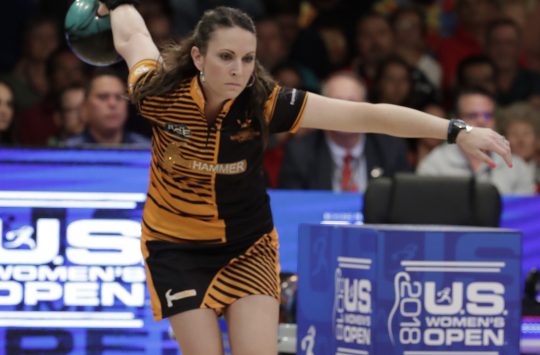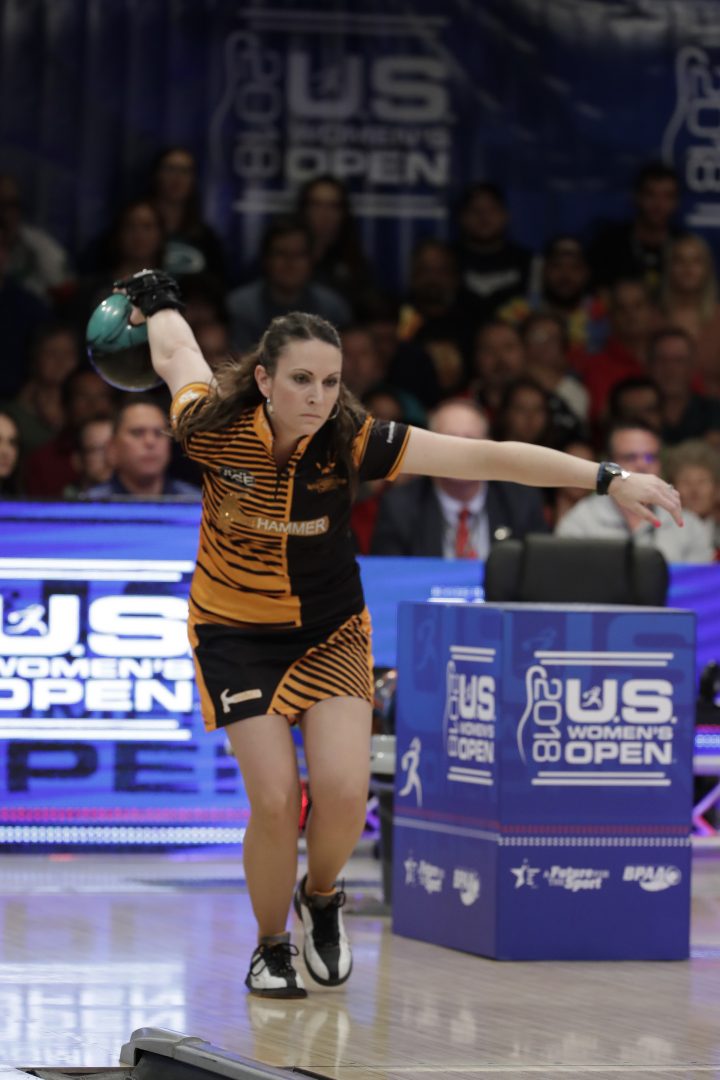Analyzing Stefanie Johnson's Game: Hard Work Produces Versatility

BY BILL SPIGNER
Stefanie Johnson started bowling when she was 6 years old. Bowling was a high school varsity sport in Florida, that’s when she became serious about the sport and decided to become a bowler rather than just a participant.
Her next step after high school was to bowl in college. She went to the University of Central Florida, and there continued to develop under the great coach, Pat Costello, a PWBA and USBC Hall of Famer. Costello’s keen eye helped Stephanie improve upon her great natural talent and further strengthen her mental game.
When the women’s tour folded in 2003, it left a void for Stefanie to pursue professional bowling as a career. Fortunately, she had made Junior Team USA, and then in 2005 made the adult squad of Team USA. She credits that as the greatest driving force for her bowling success.
Johnson had four years on the junior team, and now she has been on the adult team for 14 years — an amazing accomplishment, and one that illustrates the desire and determination to succeed at our sport has never left her.
Stefanie has one of the simplest games on the re-launched PWBA Tour. She uses a basic four-step approach, which she starts from the 12-ft. row of dots. In her set-up, she uses a good amount of knee flex. She holds the ball waist high and very close to her body, and her elbow is behind her shoulder (looking at it from a side view). Her set-up, with the combination of her knee flex and holding the ball close to her body, sets her up for a slight over-the-bar push-away, which is the start of her very loose, straight swing.
In her stance, Stefanie’s spine angle has about a 12-degree forward tilt, which she maintains through the first step. During her second step, her forward tilt increases to 22 degrees, then to 32 degrees on step three and, at release, to 42 degrees. This is a good, consistent, gradual increase in the forward spine angle throughout the approach, which is a great way to get to the line — gradually leaning forward and lowering so everything heads forward and down. Also, Stefanie’s head never moves throughout the approach, adding to her consistency.
She has great footwork, which is all natural — amazing since she never really worked on her steps. She walks heal to toe on each step except the last one, which is her slide. Her walk direction is excellent, and the spacing of her steps gets progressively longer with each step.
 Ideal Positioning: Here, Johnson is entering her slide with her right arm straight back and the ball just outside her head. She doesn’t have much lateral side tilt so the ball being outside her head is an ideal position. Her hips and shoulders are square to the direction in which she will roll the ball. Her left arm is out with the palm facing down and slightly back for balance, also very good positions to be in to fire through from the top of the swing through the release and to the finish. Copy these positions to get big results.
Ideal Positioning: Here, Johnson is entering her slide with her right arm straight back and the ball just outside her head. She doesn’t have much lateral side tilt so the ball being outside her head is an ideal position. Her hips and shoulders are square to the direction in which she will roll the ball. Her left arm is out with the palm facing down and slightly back for balance, also very good positions to be in to fire through from the top of the swing through the release and to the finish. Copy these positions to get big results.
On step one her right foot goes left about five boards, which puts it right in front of her left foot. This is considered a crossover step, kind of like walking on a balance beam, one foot in front of the other. Her second step also goes five boards left of where it was in her stance.
On step three her right foot goes back to the “balance-beam walk” and right in front of step two. Her slide comes back to the right about five boards, and ends up right in front of step three and at the board her left foot was on during her stance, effectively making her walk end up being straight.
The two steps taken with the right foot going in front of her left foot help create some space under her bowling shoulder for her swing, and keep her from walking in front of her swing. It would be beneficial for most bowlers to walk this way.
Stefanie has a very straight swing. Looking from behind the ball at the top of the swing, the ball is mostly to the right of her head. This ball position allows her swing to tuck in on the downswing to create a slightly inside-out swing through the release.
I would classify Stefanie as a straight power player, along the lines of Liz Johnson. The straight trajectory of her shot happens because she keeps her hips and shoulders straight ahead. Her loose, straight swing also contributes to a straighter shot.
The things that make her straighter shot work so well are her speed and ball rotation. Stefanie is one of the hardest-throwing players on tour, with the normal ball speed off her hand in the 18.5-mph range. Her axis tilt is about 24 degrees, which is on the high side but effective for her. Her normal axis rotation is about 55 degrees.
Stefanie is what is commonly called a speed-dominant player. She has the ability to change her delivery in order to play different parts of the lane. That allows her to take some of the lane topography issues out of play because her ball speed and tilt don’t read the lane as much as that of a player with slower ball speed, a higher rev rate and lower tilt. She can get the ball down the lane easily as it skims through the peaks and valleys of the lane surface.
Complementing her excellent physical game, Stefanie has one of the strongest mental games on tour. Her second-place finish in the 2018 U.S. Women’s Open at Boardwalk Bowl in Orlando — where she worked during her college years and won last year — could really knock some for a loop. But not her. She said it was only one game, and she’ll be back in that position again.
Stefanie will take the positives out of the experience, and move on to be ready for the next event, with no looking back. She has had a great bowling career, and with her mental attitude, I don’t see it slowing down.
LESSON PLAN
STEFANIE JOHNSON incorporates the technology of high-performance wrist devices into her game She utilizes a long one that extends out over her fingers, and a short one that extends only to the knuckles of the bowling hand.
The long one keeps her wrist and fingers stable. She just puts it on and basically forgets about anything with the hand. That allows her to concentrate on lining up, having a loose swing and not worrying about her release.
The extended wrist device that she primarily uses on tour helps to increase her rev rate and axis rotation, which are needed out there. The shorter model allows her to stay behind the ball and use her fingers more. She uses the shorter model primarily on house shots or when she needs less rotation.
Wrist devices aren’t for everyone. But when the right one is used the correct way, it is a tool to help with consistency and improving ball rotation. Check with your ball driller to see which model will help you accomplish your goals.
Bill Spigner is a Gold coach and member of the Team USA coaching team. His column, "The Pro Approach," appears bimonthly in Bowlers Journal International. To subscribe now for much more of the industry's best coverage of bowling news and incisive instructional tips and analysis, go here: /bowlers-journal-subscriptions/





